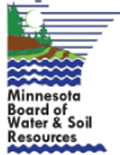Sediment control basins
![]() Taking a watershed approach to conservation isn’t necessarily a new concept in resource management, but it’s something we’re hearing more and more of in Minnesota. In some parts of the state, it’s been an informal part of local conservation for generations. In the northwest part of the state, where the Sand Hill river cuts through the southern half of Polk County, a whole host of conservation professionals and agencies have been working together for years to turn around a river system that was largely diverted, ditched, and drained throughout the early 1900s.
Taking a watershed approach to conservation isn’t necessarily a new concept in resource management, but it’s something we’re hearing more and more of in Minnesota. In some parts of the state, it’s been an informal part of local conservation for generations. In the northwest part of the state, where the Sand Hill river cuts through the southern half of Polk County, a whole host of conservation professionals and agencies have been working together for years to turn around a river system that was largely diverted, ditched, and drained throughout the early 1900s.
To understand the river’s current challenges, we have to travel back in time to the early 1950s. The Sand Hill River had been diverted from its original channel into a seemingly more useful straight ditch between the northern Minnesota towns of Fertile and Beltrami. In the 1950s, noting bank erosion and a deepening of the channel because of the straightening, the Army Corps of Engineers designed and installed four very large drop structures to try and slow down the water as it moved downstream.
Sixty years later, faced with higher overall precipitation, more frequent significant rainfall events, more aggressive agricultural practices, and record-setting floods, those structures are no longer sufficient. Not only are they struggling to keep up with greater demands, these structures also hinder fish passage and natural stream channel habitat. What to do?
The answer for the Sand Hill River includes a watershed approach. While small projects were used to try to address emerging issues like fish passage over the years, in 2011 local conservation professionals started working together in a concerted effort. The Sand Hill River Watershed District, along with East Polk Soil and Water Conservation District (SWCD) and West Polk Soil and Water Conservation District, started finding landowners interested in implementing small, strategically-placed, farmable water retention practices called “water and sediment control basins.” These structures help hold water back for a longer duration of time than a standard tile intake system. They can be farmed through, so they do not interfere with cropping, and they are cost-shareable with state and federal program money.
East Polk SWCD has received over $1.1 million from the Clean Water Fund for implementation efforts in the Sand Hill River Watershed, with more than $300,000 coming directly from the Sand Hill River WD during that time. These practices set the stage for addressing the in-stream problems in the straightened stretch. Using a 2009 design developed in partnership by the Sand Hill River WD, Houston Engineering, and the MN Department of Natural Resources, a multi-purpose solution was created that addressed the erosion and sedimentation issues and fish passage and habitat.
If you are interested in receiving more information about sediment basins near your property, please contact Lisa Newton at the East Polk SWCD at
218-563-2777.
Upper Sediment control basins

Between its headwaters and the outlet of the Polk County Ditch No. 17, the Sand Hill River is currently listed as impaired for turbidity on the MPCA’s 2014 303(d) List of Impaired Waters. The Targeted Watershed Grant received will help address these impairments by incorporating the following two components:
- Install approximately 60 water and sediment control basins on private land in cooperation with landowners. Each basin will temporarily retain water up to 36 hours. Total estimated pollution reduction leaving the field for installing the approximately 60 water and sediment control basins is 946.2 tons per year of sediment and 1,047.9 pounds of phosphorus. Application of this management measure will reduce mass load of sediment reaching waterbodies and improve the water quality and use of water resource resulting from agricultural activities.
- A natural coulee will be sustained through grade stabilization immediately upstream of is confluence of the Sand Hill River. Erosion is being caused by excessive discharge velocities within the coulee due to elevation change (30 ft) along a 4,300 ft. segment that outlets into the Sand Hill River. Pollution reduction estimates for sediment (TSS) are 332.3 tons per year and 382.2 pounds per year of phosphorus.
These projects will be completed through the cooperative efforts of the Sand Hill River Watershed, East Polk Soil and Water Conservation District and private landowners.
